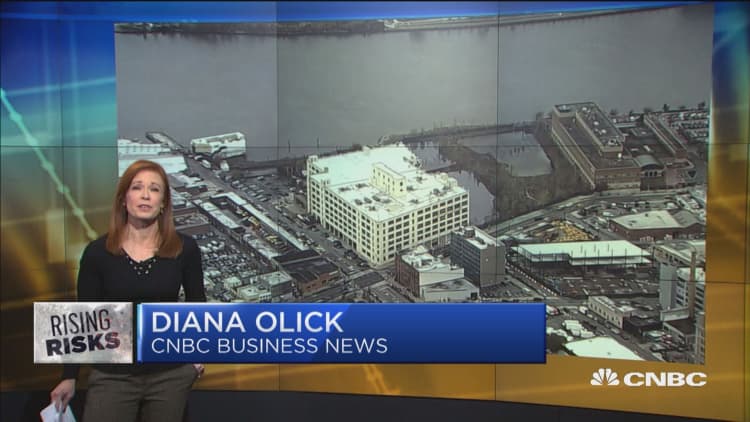
Long Island City in Queens, N.Y., may seem ideal for Amazon. Directly across the East River from Manhattan, it offers stunning views, easy access to transportation, and shiny new residential towers already rising by the water.
But there is a growing risk to it: The proposed 4 million to 8 million square-foot complex would be located in a flood plain.
New research from Climate Central and Zillow shows the area could see significant coastal flooding by 2020. By 2050, extreme projections of sea level rise have low-lying buildings under water.
"One of the reasons Amazon got so big was long-term thinking, but building in the lowest spot in Queens is not long-term thinking," said Benjamin Strauss, CEO and chief scientist at Climate Central. "This is clearly building square in the danger zone for frequent flooding."
Amazon can build sea walls and barriers and take other steps to make its new headquarters resilient, like developers are doing at nearby Brooklyn Navy Yards' new Dock 72, that literally hangs over the water. It is a collaboration by Boston Properties and Rudin Management.
"We have a very strong plan in terms of sustainability and dealing with storms," said William Rudin, CEO of Rudin Management. "Our lobby is 8 feet above the water level. All the mechanicals are on the second and third floor. We are very focused on resiliency."
The same is true at the massive Hudson Yards development on Manhattan's West Side, also built right by a river but over train yards, so it is elevated. Amazon could raise the ground under its new offices and raise all the building systems.
"Whenever you do things that are different that haven't been done, you're going to have greater cost," said Stephen Ross, Chairman of the Related Companies, which is developing Hudson Yards. "So we're able to offer, really, a resilient community, embracing all the latest in technology, in every aspect of it."
Superstorm Sandy caused massive flooding in Long Island City, and the area now experiences floods almost any time there is a heavy downpour.
"And the truth is, heavy rain has already increased by 50 percent in the Northeast. So we can expect that trend to continue. It gets warmer, it means the air can hold more moisture and we get bigger downpours," said Strauss of Climate Central.
From 2005 to 2014, Queens saw an additional 31 days of coastal flooding due to climate change, researchers say. If Queens experienced a 6-foot flood, which scientists expect by the end of this century, that would put $13 billion worth of property at risk of damage, including about 34,000 homes, according to Climate Central and Zillow.
Companies and residential developers continue to build on the water because that is simply where people want to live and work. Long Island City is already becoming a hot spot for New York City, and Amazon will speed that change exponentially. New York City is also running out of large spaces for developments like this one, which likely played into the choice.
Amazon is more than likely considering all these risks as it plans its new headquarters, although a spokesman for the company said they could not comment on any plans. Like other waterfront buildings, the new headquarters will have to be built as a stronghold — resilient against weather and water.
"But then you have to ask how easy will it be to get to and from their headquarters, what's happening to the surrounding neighborhood? And they're going to need the city's help to fortify the whole area," Strauss said.
-- CNBC's Erica Posse and Lisa Rizzolo contributed to this report


